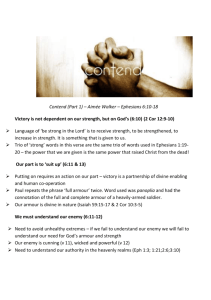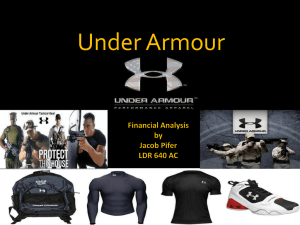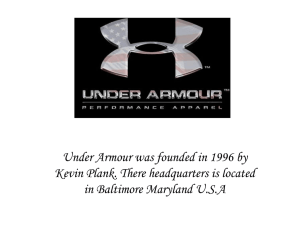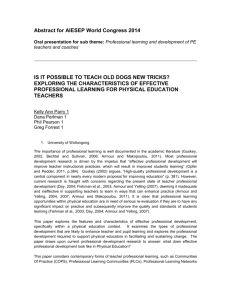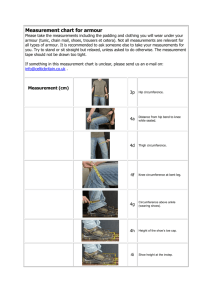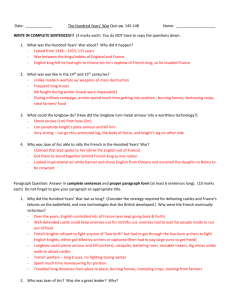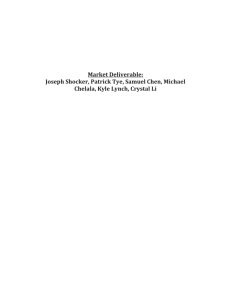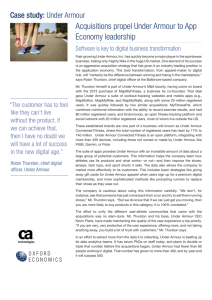Under Armour Brand Audit Ryan Holloway University of Texas at
advertisement
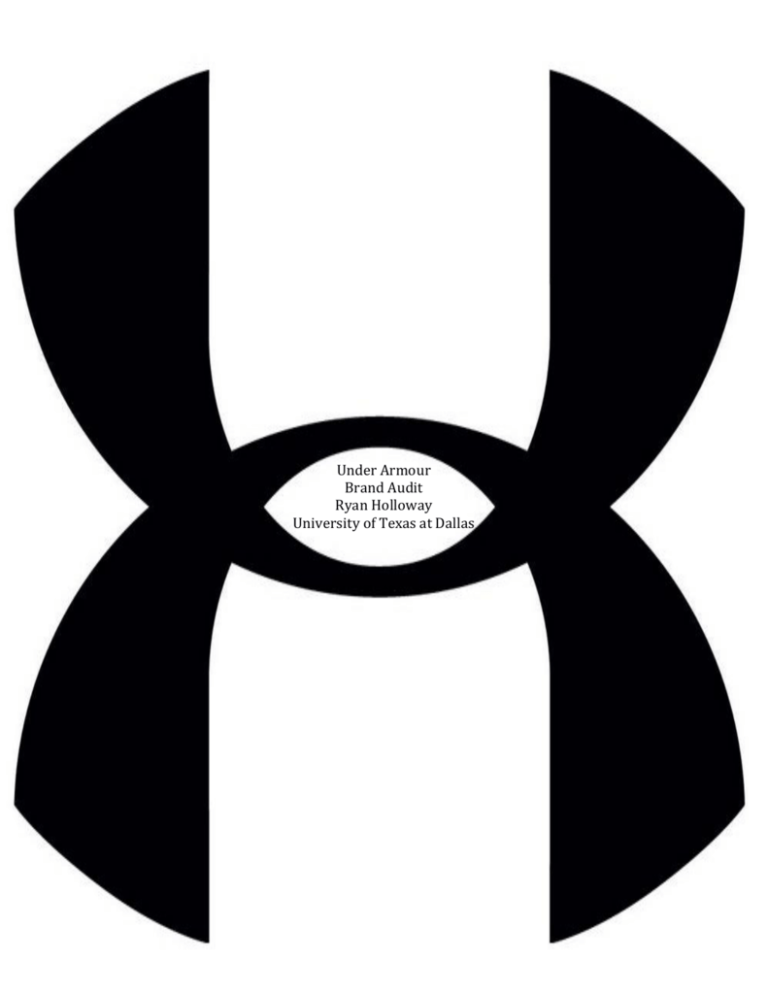
Under Armour Brand Audit Ryan Holloway University of Texas at Dallas I. Brand Inventory A. Company Overview 1. History and Inception Under Armour was founded in 1996 by Chairman and Chief Executive Officer, Kevin A. Plank in his grandmother’s home in Washington D.C. Plank played for the University of Maryland as the special teams captain of their football team. Plank, along with other teammates, were having trouble with their sweat drenched shirts and the weight they brought with them. Plank found that the compression shorts they wore (which were designed to keep muscles relaxed) remained dry and comfortable. In 1995 Plank was a senior at the University of Maryland and sought out a solution to fix the wet T-shirt problem. Plank found fabric that was similar to what the compression shorts were made of at a local fabric store, and had sample shirts made. Plank tested them on his teammates, along with the eventual Chief Operating Officer and President of Product, Kip J. Fulks, who was playing for the University of Maryland lacrosse team at the time. At first the prototypes had a bad reception from the players because of the lingerie-like material, but once they were worn their minds were quickly changed because they proved to be extremely comfortable and virtually sweat-free. Plank graduated in 1996, and with the $40,000 he had saved throughout his college years, officially started Under Armour Athletic Apparel. Because of his NCAA career at the University of Maryland, Plank already had many collegiate and professional contacts within the sports industry. Plank packed the trunk of his car with Under Armour apparel and shopped the samples around the country to college sports teams. Georgia Institute of Technology and Arizona State University were the first customers of the sports gear, and from there the company took off. Plank and Fulks set up their headquarters in Baltimore, Maryland where it remains today. 2. Subsidiaries Under Armour’s principle subsidiaries are located in Canada, Hong Kong, China, and The Netherlands. Under Armour has also acquired 100% of MapMyFitness on December 6, 2014, a digital connected fitness platform that allows users to track their fitness activity via smartphone applications or online, for an estimated $150 million. The deal was made to compete and keep pace in the digital fitness world with Nike and other competitors. They also expect to increase their sales and awareness of their current products to stay relevant in the market. 3. Recent News Under Armour was recently named Ad Age’s 2014 Marketer of the Year. The title was won largely in part of its recent women’s $15 million campaign, “I Will What I Want.” The campaign is made to increase women’s awareness of the brand and elevate their existing line. Ad Age’s E.J. Shultz writes, “"[L]ately the company's sales — not its clothes — are on fire, thanks to a groundbreaking women's campaign, smart PR and a take-no-prisoners approach." 4. Key Personnel Name Age Position Kevin A. Plank 41 Chairman and CEO Brad Dickerson 49 Chief Financial Officer Kip J. Fulks 41 COO and President of Product James H. Hardy, Jr. 54 Chief Supply Chain Officer Karl-Heinz Maurath 52 President, International Matthew C. Mirchin 54 Executive VP, Global Marketing Adam Peake 45 Senior VP of Sales North America Henry B. Stafford 39 President, North America B. Category and Competition 1. Category Definition Under Armour is apart of the performance apparel category including branded sportswear, footwear, and accessories for men, women and youth. The category includes other sporting apparel companies, but mainly competing with Adidas AG, Colombia Sportswear Company, and perhaps their largest competitor, Nike Inc. 2. Methods of Distribution Majority of Under Armour’s sales are generated through the national and regional wholesale sporting goods chains, independent and specialty retailers, department store chains, institutional athletic departments and leagues and teams. Under Armour also sells directly to consumers through their own brand and factory stores in their North America and Asia segments. They also sell to consumers directly through their website operations in North America and in some countries in Europe. Under Armour believes the best way to build their brand awareness throughout the globe to broaden their distribution and consumer-base is by selling their performance apparel to professional sports teams where consumers can see Under Armour’s products being used by their favorite athletes. 3. Seasonal Factors Under Armour does not necessarily have seasonal factors that affect their business and sales. They offer their patented ColdGear, HeatGear, and AllSeasonGear to avoid issues of decreased sales. This reduces the regional factors as well because they do not have to worry too much about weather conditions affecting sales. However, Under Armour has noticed a trend upward in their sales during the fall seasons due to the holidays, and their ColdGear, which is made particularly for the cold, is priced a bit higher than other products. 4. Competition As mentioned before, Under Armour’s biggest competitors and major players within the market are Adidas AG, Colombia Sportswear Company, and Nike Inc. They also compete with smaller sportswear and athletic apparel companies trying to make their mark in the segment. Many of Under Armour’s competitors already have strong brand recognition across the globe, and a greater supply of resources like Nike and Adidas for example. Not only does Under Armour compete with these companies for purchasing decisions, they must also tackle the competition for limited floor space the retailers provide. Under Armour has been successful in this because of their developed relationships and their actual sales speak for themselves. Under Armour believes they have been successful in competing with these major players because of their strong brand image and recognition, the quality and reliability of the products they provide, and their distribution methods. C. Products Within Category 1. Products Under Armour offers a variety of products consisting of apparel, footwear, and accessories for men, women, and youth. These products are offered at multiple price levels that are believed to provide customers with superior alternatives to traditional athletic products. Their apparel products provide 76% of Under Armour’s net revenues while footwear represents 13% and accessories offer 9% of net revenues. They also have licensing arrangements that cover the remaining 2% of revenues. The apparel that Under Armour provides are offered in many different styles and fits that are intended to exhibit peak comfort and mobility while regulating body temperature, and improve performance regardless of weather conditions. The apparel offered are there patented HeatGear when it is hot, ColdGear when it is cold, and AllSeasonGear for the in between extreme weather elements. Within the gearline offered, there are three different primary fit types including compression (tight fit), fitted (athletic fit), and loose (relaxed fit). 2. Product Benefits and Innovations Under Armour’s HeatGear is specifically made for warm to hot temperatures to replace the sweat-soaked non-performance T-shirt that can weigh up to two to three pounds. HeatGear is designed with a microfiber blend to wick moisture in order to keep the body cool, dry, and light. It is offered in a variety of tops and bottoms with many different styles and colors to choose from. ColdGear is engineered to wick moisture from the body, circulating body heat from hot spots in order to maintain core body temperature. This type of apparel is designed for dryness and warmth in a light layer to be worn underneath a jersey, uniform, or equipment. This product generally sells at higher prices than the other gearlines. The AllSeasonGear is to be worn in between extreme temperatures. It’s technical design and fabrics keep the user cool and dry in warmer weather while preventing the wearer from becoming cold in cooler temperatures. The footwear Under Armour provides includes football, baseball, lacrosse, softball, and soccer cleats, slides, performance training, running, and basketball footwear, along with hunting boots. The footwear is designed to be light, breathable, and built with performance attributes for athletes. They provide stabilization, directional cushioning, and moisture management, just like their apparel, to maximize the comfort and control of the athlete. The accessory products that Under Armour sells include headwear, bags, and gloves. They also use their patented HeatGear and ColdGear technologies to ensure the same level of performance standard as their apparel D. Brand/SWOT Analysis 1. Top Brand Market Share 2. Revenue Growth: Under Armour vs Nike 3. Under Armour Price % Change vs Competitors 4. 5. SWOT Analysis Strengths Customer Loyalty Innovative Culture Free Endorsements Nice Brand Unique Technology Opportunities International Expansion Designs in Fabric Technology Licensing Agreements Variety of Sports Categories Diversified Weaknesses Limited Product Range Loss of Military Market Relatively Small Size Company Higher Pricing Low Barriers to Entry Threats Weak Sales in Uninformed Countries Global Economy Can Hurt Growth Intense Competition Lacks Female Focus 6. Share/Revenues by Region North America accounted for 94% of Under Armour’s net revenues for 2013, and only approximately 6% of their net revenues came from outside North America. These regions include, Europe, the Middle East, Asia, and Latin America. This is shown by the chart below: E. Consumer Profile 1. Demographic Under Armour’s target audience is geared towards men and women who primarily live an active lifestyle in athletics, fitness, training and outdoor activities. Realistically ranging in age from those who are starting sports at a young age all the way up to those who are able to still be active and fit. However, their marketing and promotion strategy begins with providing and selling their products to highperforming athletes and teams in the high school, collegiate, and professional levels. 2. Purchase Cycle/Place of Purchase Under Armour recognizes that majority of their income is coming from the last two quarters of the calendar year during the fall selling season. They have noticed a spike in their volume of sales during these two quarters. The levels of Under Armour’s working capital reflect the seasonality of their growth. Their inventory, accounts payable, and other accrued expenses are expected to be higher in the second and third quarters in preparation for the fall and winter seasons. Under Armour’s products are available to consumers through wholesale channels which include nation and regional sporting goods chains, independent and specialty retailers, department store chains, institutional athletic departments, and leagues and teams. They also sell products to independent distributors in different countries where there are no direct sales operations. They also provide consumers with direct channels through their own network of brand and factory house stores in North America and Asia. They also have website operations in North America and in certain countries in Europe. Wholesale operations represented 68% of sales while direct consumer channels and licensing channels only provided 30% and 2% of sales respectively. 3. Brand Loyalty Under Armour tries to establish their loyalty by marketing to the younger athlete and having them grow up with the brand. They try to bring the brand and the name to places the teen athletes normally go. Under Armour’s vice president of global direct, Mark Kuhns says, “it's not about pushing a sales message at them or following them all over the place to tell them about Under Armour; it's about being in places where they naturally go. They have a chance to interact with our brand.” They have an integrated marketing strategy built on creating an emotion connection with the younger generation of athletes making them feel as though Under Armour is a brand they can trust. Trust fosters loyalty and a lifetime relationship that can be passed down from generation to generation. The numbers support this strategy as the company continues to grow year after year, and even quarter after quarter. F. Marketing, Media, and Promotion 1. Advertising Under Armour is most notorious for outfitting some of the world’s most renowned athletes with their products. Consumers gain awareness through their favorite athletes and teams wearing Under Armour’s gear. They also gained some attention and success by providing the characters with Under Armour’s gear in the movies Any Given Sunday and The Replacements. They found immediate success with these movies and by the year’s end had sold 250,000 garments. One of Under Armour’s most famous advertising campaign was the “Click-Clack” campaign in 2006-2007. This was the company’s first attempt at producing footwear. Click-Clack resembled the sound that football cleats made on hard surfaces. With this campaign they were able to gain 23% of the market share in its first year. The major success Under Armour had with the campaign allowed them to venture into other various sports footwear such as baseball, softball, and lacrosse players. While finally, in 2008, Under Armour came out with its first line of athletic cross-training footwear. This paved the way to a whole new segment of the athletic training market. The new performance trainer footwear was dedicated to runners of all types. The performance trainer campaign was like no other in Under Armour’s history including months of advertising teasers with high-performing athletes. All of these teasers were ramping up to the eventual commercial spot in the 2008 Super Bowl, the United States’ most watched sporting event. Wayne Marino, the Chief Financial Officer at the time, was quoted as describing this advertising campaign the “defining moment” for the future of the company. This campaign held so much weight with its success, that in spite of the economic downturn, Under Armour was able to proceed with their brand new footwear line, UA Run. 2. Media Under Armour promotes their products in many different national digital, broadcast, and print outlets. Under Armour also utilizes social marketing to raise awareness to customers and engage consumers in conversation around the Under Armour brand and products. 3. Marketing Spending Due to the growth and projected sales, Under Armour is going to increase their advertisement budget by one-third from a year ago. Chief Executive Officer, Kevin Plank, told analysts that he expects to allocate 11% of the companies revenues to marketing and promotion. In dollar terms that is $300 million, which is a $83.5 million increase (34%) from over a year ago. G. Brand Value The Under Armour brand value is with out a doubt ahead of most sports apparel companies in the market. The numbers of revenue, sales, and market share clearly speak for themselves. Under Armour continues to grow into a worldwide leader in high-performance sporting apparel. Ad Age’s “Marketer of the Year” award along with Kevin Plank’s three-year plan to earn $4 billion in revenue by 2016 shows the increase in value this year alone. Under Armour will continue to grow and prosper as they continue to look and find new and innovative ways to improve their products with cutting-edge technology. II. Brand Exploratory A. Research In order to receive a proper understanding of the brand awareness, associations, image, and relationships I surveyed five different individuals with questions regarding the Under Armour brand. These questions were based on their knowledge of the brand, their own personal experiences with the brand, and basic thoughts they had regarding the Under Armour brand itself. What do you think of when you hear the word “Under Armour” The majority of respondents used words and phrases such as “sports” “sports apparel” “athletic wear” “stretchy shirts” and even different athletes were mentioned. So 3 out of the 5 respondents (60%) mentioned sports or athletics. This is a huge positive for Under Armour because it shows that they have established themselves in the athletic market, and consumers are aware of what they sell and who they endorse. Where do you go when you want to buy athletic apparel? There were several different answers for this question, and most did not really favor Under Armour. Respondents answered with the Nike or Adidas outlet stores, and some shopped at Kohl’s. Not a single person said they shopped at or for Under Armour. This I believe has to do with the lower price points that the outlet stores provide. Also, Under Armour isn’t even sold out of Kohl’s, however, Nike and Adidas are. When told, most respondents were not even aware of the Under Armour outlet store located next to the Nike and Adidas outlet stores. This shows Under Armour needs to do a better job of promoting or gaining more awareness of bargain shopper. What do you like about Under Armour products? The response to this question was the same across the board. The respondents liked the comfort and style of the apparel, and the dryness that comes along with it. This is also a plus for Under Armour because they clearly follow through on what they promote and stand for. What do you dislike about Under Armour products? There was no doubt that the answer would mainly be the same with the respondents to this question as well. They all did not like the higher price points that Under Armour tends to have. Under Armour promotes quality, which is the reason they have the ability to price their clothing so high. Their profits would suffer as well if they were to lower the pricing as their margins would decrease. When was the last time you bought an Under Armour product? I asked this question because I wanted to get an understanding of how often someone actually needs to buy new athletic gear or shirts to go to the gym. In my personal opinion, aside from shoes, I feel the need to buy a few shirts at a time to last me a couple of years. Which is why the answers to this particular question surprised me. Even though every respondent said they would shop at Nike or Adidas before turning to Under Armour, every single respondent said they had bought an Under Armour product in the last year. And 2 of the 5 respondents (40%) said they are planning on buying another product in the near future. I attribute this response to Under Armour’s website and online operations because none of the respondents would go to an Under Armour store to buy sports apparel. B. Recommendations If I were to recommend something to improve Under Armour it would be to appeal to the bargain shopper a little more than they do. I am not necessarily saying to reduce their prices, but instead make them more aware of special deals and offers they may have on out of season styles, or older styles to make room for the brand new lines. In the survey that was conducted for example, no one knew there was an Under Armour outlet store that is accessible to them. Another recommendation that I would have for Under Armour is to keep doing exactly what they are currently doing. Under Armour is on the rise and have been for a long time now. They continue to grow every year and making a huge mark in the sports apparel industry. They have a long way to go to catch up to Nike, but if they stay on the track they are on right now they have a chance of becoming the worldwide leader in athletic wear. Works Cited Davis, A. (2014, June 4). Price % change [Photograph]. Retrieved from http://www.forbes.com/sites/alexadavis/2014/06/04/why-jefferiessays-under-armour-is-a-buy-right-now/ Empson, R. (2013, November 14). Under Armour Buys Mobile Workout Veteran MapMyFitness For $150M As It Looks To Keep Pace In Digital Fitness. Retrieved December 17, 2014, from Tech Crunch website: http://techcrunch.com/2013/11/14/under-armour-puts-down-150m-toacquire-fitness-tracking-platform-maymyfitness-and-its-20m-users/ Keenan, J. (2009, October). Cover story: Growing up with under armour. Retrieved December 17, 2014, from Retail Online Integration website: http://www.retailonlineintegration.com/article/social-media-branding412982/1 Meehan, S. (2014). Under Armour named Ad Age's Marketer of the Year. American City Business Journals. Retrieved from Factiva database. (Accession No. BALBJO0020141208eac80002u) Peterson, H. (2014, October 23). Under armour is becoming a viable threat to nike. Retrieved December 17, 2014, from Business insider website: http://www.businessinsider.com/under-armour-is-a-threat-to-nike-201410 Rhodes, N. (n.d.). Under armour, inc. In International directory of company histories. Vol. 150, pp. 496-500, 2014, Detroit, MI: St. James Press) Retrieved from Gale Virtual Reference Library database. (Accession No. GALE|CX2785100104) Roberts, D. (2011, October 26). Under armour gets serious. Retrieved December 17, 2014, from Fortune website: http://fortune.com/2011/10/26/underarmour-gets-serious/ Securities Exchange and Commission. (2014, February). Form 10-K. Baltimore, MD. http://investor.underarmour.com/secfiling.cfm?filingID=1336917-14-8 Under armour swot analysis. (2014). Retrieved December 17, 2014, from Wiki Wealth website: http://www.wikiwealth.com/swot-analysis:ua Zmuda, N. (2014, April 24). Under armour adds millions to marketing budget. Retrieved December 17, 2014, from Advertising Age website: http://adage.com/article/cmo-strategy/armour-adds-millions-marketingbudget/292854/
